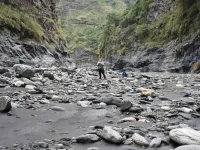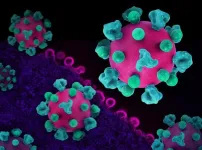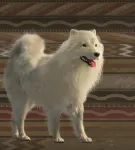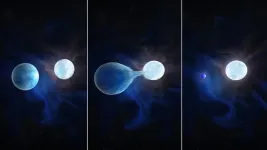(Press-News.org) Herpes simplex virus (HSV) is extremely common, affecting nearly two-thirds of the world’s population, according to the World Health Organization.
Once inside the body, HSV establishes a latent infection that periodically awakens, causing painful blisters on the skin, typically around the nose and mouth. While a mere nuisance for most people, HSV can also lead to dangerous eye infections and brain inflammation in some people and cause life-threatening infections in newborns.
Researchers have long known that the virus and the host immune system are in a perpetual competition, but why does this battle reach a stasis in most people while causing serious infections in others?
More important, precisely how does the battle unfold at the level of cells and molecules? This question has continued to bedevil scientists and hamper the quest for treatments that prevent or cure infections.
A recent study by researchers at Harvard Medical School, conducted using lab-engineered cells and published in PNAS, unveils the precise maneuvers used by host and pathogen in the fight for dominance of the cell.
Furthermore, the research shows how the immune system keeps the virus at bay in a battle taking place at the control center of the cell — its nucleus.
Immune signaling proteins issue a call to arms
The research reveals a key role for a group of signaling proteins called interferons, which recruit other protective molecules and block the virus from establishing infection.
Once inside the host, HSV multiplies by making copies of itself inside the nuclei of cells, using the host’s genetic machinery. For that to happen, the virus must outcompete the host’s immune system. But many of the tactics the virus and the immune system use in this contest have remained a mystery, making it challenging to design medicines to help patients defeat the virus.
Interferons — named for their ability to interfere with pathogens’ attempts to infect cells — are signaling molecules released when the immune system detects the presence of microbes, such as viruses. The distress signals sent by interferons activate genes in that cell and other cells that produce proteins, which in turn block viruses from establishing infection in the first place.
Several different mechanisms that interferons use to thwart viruses within the cytoplasm, the gelatinous liquid that fills cells, are well known. But how interferons work against DNA viruses — those launching their attack within the cell nucleus — has remained elusive.
“We know a lot about how interferon and immune stimulants work against viruses in the cytoplasmic body of the cell, but up until now, we knew very little about how the immune system blocks viral infection in the cell’s nucleus,” said study senior author David Knipe, the Higgins Professor of Microbiology and Molecular Genetics in the Blavatnik Institute at HMS. “Our findings define the mechanisms of action of any treatment that induces interferons and how they can prevent and treat infections from HSV, as well as other herpesviruses and nuclear DNA viruses.”
Knipe said the insights from this work could also help researchers understand — and perhaps eventually develop treatments for — other nuclear DNA viruses, including well-known troublemakers like the Epstein-Barr virus, which causes mononucleosis; human papillomavirus; hepatitis B; and smallpox.
These results define the mechanisms of action of interferon treatments for herpesvirus diseases and other treatments such as toll-like receptor ligands that have been tested for herpes, the researchers said. Other new activators of interferons such as cGAS agonists could also be used to induce herpes resistance through the newly defined mechanisms, the researchers added.
The researchers caution that any new potential therapies for HSV and other DNA viruses are purely conceptual at this point. Any such approaches should be first tested in small animals such as mice, then in larger animals and, finally, in humans.
Mapping the steps of a viral arms race
In the new study, Knipe and co-author Catherine Sodroski, an HMS PhD graduate now at the National Institutes of Health, discovered that a host protein called IFI16 is recruited by interferon to help block the virus from reproducing in several ways.
One of the strategies used by IFI16 to fend off HSV involves building and maintaining a shell of molecules around the viral DNA genome. This molecular “bubble wrap” prevents the virus from unfurling. With the virus wrapped up, it can’t activate its DNA to express its genes and make copies of itself.
To counter these protective maneuvers, however, the virus produces molecules called VP16 and ICP0 that can remove the wrapping, deactivate the host cell’s protective molecules, and enable the virus to reproduce.
Another mechanism used by IFI16 to fight HSV infection is to neutralize VP16 and ICP016. Under normal circumstances, when the cell is not preparing to repel a viral invader, there is some IFI16 present within the nucleus. But this background level of IFI16 isn’t enough to fight off the viral helper proteins and keep the virus wrapped and restrained.
Without interferon’s call to the cell to send in more IFI16, the virus wins the arms race and infects the cell. However, the experiments showed, when interferon signals recruit higher levels of IFI16, the immune system wins.
This current study echoes similar findings that found elevated levels of IFI16 in clinical samples of tissues where the immune system appeared to be successfully controlling symptoms of the closely related HSV-2 virus, providing crucial insights about the molecular machinery at work in staving off outbreaks of symptoms.
Using insights from the lab to improve human health
Knipe says he became interested in the biology of herpesviruses as an undergraduate while recovering from a bout of mononucleosis. He turned that curiosity into a career.
The Knipe lab studies what happens at the level of molecules and cells when HSV causes symptomatic and dormant infections. He is particularly interested in how the host immune system responds to HSV. Knipe has applied the insights gained by studying HSV to explore the possibilities of using genetic material from HSV to deliver vaccines for HIV, SARS, West Nile, and anthrax.
“Solving the puzzles that underlie the basic biology of how these viruses interact with the host cell nucleus and immune system is endlessly fascinating, and finding new ways to apply that knowledge to fighting diseases is endlessly rewarding,” Knipe said. “The most exciting part is that we’re just scratching the surface of the deep knowledge we can tap into for this fight.”
Authorship, funding, disclosures
This research was supported by National Institutes of Health predoctoral fellowship F31 AI145062 and National Institutes of Health grant AI106934.
END
How the immune system fights to keep herpes at bay
New study findings could inform the design of treatments for a range of viruses that replicate in the cell nucleus
2023-12-14
ELSE PRESS RELEASES FROM THIS DATE:
Drones capture new clues about how water shapes mountain ranges over time
2023-12-14
UNIVERSITY PARK, Pa. — Drones flying along miles of rivers in the steep, mountainous terrain of central Taiwan and mapping the rock properties have revealed new clues about how water helps shape mountains over geological time, according to a team led by Penn State scientists.
The researchers found a link between the size of boulders in the rivers and the steepness of the rivers. The link shows how rock properties can influence the relationship between tectonic processes happening deep underground and how mountainous landscapes ...
NIH research identifies opportunities to improve future HIV vaccine candidates
2023-12-14
WHAT:
An effective HIV vaccine may need to prompt strong responses from immune cells called CD8+ T cells to protect people from acquiring HIV, according to a new study from researchers at the National Institute of Allergy and Infectious Diseases (NIAID), part of the National Institutes of Health, and colleagues. The study findings, appearing in Science, draw comparisons between the immune system activity of past HIV vaccine study participants and people with HIV who naturally keep the virus from replicating even in the absence of antiretroviral ...
Can an app improve your romantic relationship?
2023-12-14
Half of all marriages in the United States are likely to fail by the time the spouses reach their 50s. Understandably, many couples are looking for ways to avoid becoming part of that statistic, well aware of a divorce’s possible wide-reaching detrimental effects on families, children, personal finances, individual well-being—and direct and indirect costs to society.
Ronald Rogge, an associate professor of psychology at the University of Rochester, has been researching the complex dynamics ...
Climate-smart ocean planning in Antarctica awarded with 1.5M€ ERC starting grant
2023-12-14
Catarina Frazão Santos, researcher at the Faculty of Sciences of the University of Lisbon (Portugal) (Ciências ULisboa), has been awarded by the European Research Council (ERC) with a Starting Grant of approximately 1.5 million euros to study the benefits and challenges of developing sustainable, equitable and climate-smart marine spatial planning processes in Antarctica and beyond.
“We need to raise awareness and foster a ‘paradigm shift’ on how to plan for sustainability and equity in a changing ocean,” says Catarina ...
Researchers, Coast Salish people analyze 160-year-old indigenous dog pelt in the Smithsonian’s collection
2023-12-14
Researchers from the Smithsonian’s National Museum of Natural History led a new analysis that sheds light on the ancestry and genetics of woolly dogs, a now extinct breed of dog that was a fixture of Indigenous Coast Salish communities in the Pacific Northwest for millennia. Anthropologist Logan Kistler and evolutionary molecular biologist Audrey Lin analyzed genetic clues preserved in the pelt of “Mutton,” the only known woolly dog fleece in the world, to pinpoint the genes responsible for their ...
Diverse gut bacteria communities protect against harmful pathogens by nutrient blocking
2023-12-14
UNDER EMBARGO UNTIL 19:00 GMT / 14:00 ET THURSDAY 14 DECEMBER 2023
Diverse gut bacteria communities protect against harmful pathogens by nutrient blocking
New study demonstrates that diverse communities of resident bacteria can protect the human gut from disease-causing microorganisms.
However, this protective effect is lost when only single species of gut bacteria are present.
The researchers found that protective communities block the growth of harmful pathogens by consuming nutrients that the pathogen needs.
The findings, published today in the journal Science, could help to develop new strategies to optimise gut health.
The ...
Astronomers discover first population of binary stripped stars
2023-12-14
Astronomers at the University of Toronto have discovered a population of massive stars that have been stripped of their hydrogen envelopes by their companions in binary systems. The findings, published today in Science, shed light on the hot helium stars that are believed to be the origins of hydrogen-poor core-collapse supernovae and neutron star mergers.
For over a decade, scientists have theorized that approximately one in three massive stars are stripped of their hydrogen envelope in binary systems. Yet, until now, only one possible candidate had been identified.
“This was such a big, glaring hole,” says co-lead author ...
Ancient genomics and Indigenous Knowledge reveal history of Coast Salish “woolly dogs”
2023-12-14
DNA analysis of a 19th-century dog, paired with traditional knowledge acquired through interviews, have together provided new insights into the decline of Coast Salish “woolly dogs” – an extinct Indigenous dog once bred for its unique woolly coat. Dogs were introduced to the Americas at least 15,000 years ago and have been ubiquitous in Indigenous societies across the continents for thousands of years. Coast Salish peoples – a group of Indigenous societies that lived in the Salish Sea region of the Pacific Northwest (PNW) – kept several different types of dogs, including a special lineage of “woolly ...
Science’s 2023 Breakthrough of the Year: GLP-1 agonists show promise for obesity-associated health problems
2023-12-14
Science has named the development of glucagon like peptide-1 (GLP-1) agonists and this year’s discovery that these drugs can blunt obesity-associated health problems as its 2023 Breakthrough of The Year. Although obesity’s causes span genetic, physiological, environmental, and social factors, as a medical problem, obesity’s risks can be life-threatening – including heart disease, diabetes, arthritis, liver disease, and certain cancers. Drug treatments for obesity have had “a sorry past, one often intertwined with social pressure to lose weight and the widespread belief that excess weight reflects weak willpower,” writes ...
Using genomics to map illegal pangolin poaching from Africa to Asia
2023-12-14
Genomic analyses reveal illegal pangolin trafficking routes from origins in Africa to markets in Asia, researchers report. The approach offers new opportunities to monitor pangolin poaching in near real-time, allowing for targeted and more effective anti-trafficking measures. The illegal wildlife trade is a significant driver of global biodiversity loss. Of all the species poached and traded, the white-bellied pangolin (Phataginus tricuspis) is the world’s most trafficked mammal and is at risk of extinction. Pangolins are in high demand in Asia because their scales are believed, without scientific support, ...
LAST 30 PRESS RELEASES:
58% of patients affected by 2022 mpox outbreak report lasting physical symptoms
Golden Gate method enables rapid, fully-synthetic engineering of therapeutically relevant bacteriophages
Polar weather on Jupiter and Saturn hints at the planets’ interior details
Socio-environmental movements: key global guardians of biodiversity amid rising violence
Global warming and CO2 emissions 56 million years ago resulted in massive forest fires and soil erosion
Hidden order in quantum chaos: the pseudogap
Exploring why adapting to the environment is more difficult as people age
Society for Laboratory Automation and Screening welcomes new scientific director: Madeline M. Farley, Ph.D.
Austrian cow shows first case of flexible, multi-purpose tool use in cattle
Human nasal passages defend against the common cold and help determine how sick we get
Research alert: Spreading drug costs over the year may ease financial burden for Medicare cancer patients
Hospital partnership improves follow up scans, decreases long term risk after aortic repair
Layered hydrogen silicane for safe, lightweight, and energy-efficient hydrogen carrier
Observing positronium beam as a quantum matter wave for the first time
IEEE study investigates the effects of pointing error on quantum key distribution systems
Analyzing submerged fault structures to predict future earthquakes in Türkiye
Quantum ‘alchemy’ made feasible with excitons
‘Revoice’ device gives stroke patients their voice back
USF-led study: AI helps reveal global surge in floating algae
New method predicts asthma attacks up to five years in advance
Researchers publish first ever structural engineering manual for bamboo
National poll: Less than half of parents say swearing is never OK for kids
Decades of suffering: Long-term mental health outcomes of Kurdish chemical gas attacks
Interactional dynamics of self-assessment and advice in peer reflection on microteaching
When aging affects the young: Revealing the weight of caregiving on teenagers
Can Canada’s health systems handle increased demand during FIFA World Cup?
Autistic and non-autistic faces may “speak a different language” when expressing emotion
No clear evidence that cannabis-based medicines relieve chronic nerve pain
Pioneering second-order nonlinear vibrational nanoscopy for interfacial molecular systems beyond the diffraction limit
Bottleneck in hydrogen distribution jeopardises billions in clean energy
[Press-News.org] How the immune system fights to keep herpes at bayNew study findings could inform the design of treatments for a range of viruses that replicate in the cell nucleus





